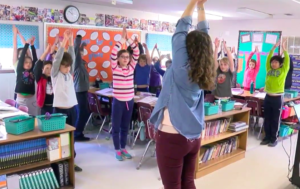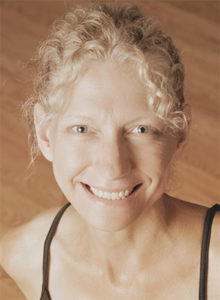
|
Join us for our LIVE REMOTE "Yoga & Mindfulness in the Classroom" Training on June 12th! . Sign Up Now!
|

As a school psychologist, I’m lucky to get to share yoga and mindfulness education every week in an amazing elementary school in Indiana. This school isn’t amazing because it has wealth or prestige. Quite the opposite, in fact; many students at this school have had few privileges or perks in their young lives.
The other day, a first-grader tugged at my sleeve.
“Guess what? I don’t have any parents.”
I fumbled for a reply, finally settling on, “Well, I’m really glad you are here today.”
And I was because we were getting ready to take a mindful moment using a program called Yoga 4 Classrooms. We were learning how to breathe and move and calm ourselves. We were learning to be mindful, gain the ability to regulate our emotions while creating a safe, productive classroom climate.
The teachers at this school are significantly challenged on a daily basis, but they are just as amazing as the kids. Last week, several told me they planned to use techniques from their Yoga 4 Classrooms Activity Card Decks to help their students get through ISTEP+, our state’s version of the annual, high-stakes assessments. Of course, the “new and improved” version of the test is longer and more rigorous than the previous one. My understanding is that most adults would be lucky to pass the assessment for third-graders!
So, yeah, stress levels at this school have been high of late. A little girl plucked out her eyebrow hairs, one at a time, due to anxiety over these tests. Many students wither and fade. Some lash out; others engage in serious self-harm.
I sometimes wonder if we are fueling a mental health crisis in our children. But no one asked my opinion on the value of the new mega-assessments. If I were asked, here’s what I’d say:
While we try to find more reasonable ways to assess student growth and progress, we must give young people the tools needed to thrive in a fast-paced, high-pressure world. I’m talking about real-life, in-the-moment things they can do when anxiety begins to peck.
Many educators out there are working to shift the climate of their classrooms and schools to a more positive place. At my school, I help equip my beloved teachers and students with self-regulation techniques that help improve their resilience and well-being short and long-term. Whatever demands the state hurls at these good folks, I believe they will be okay.
Here are a couple of inspiring stories from educators who have also taken action in their schools:

Jacqueline Killorin is a kindergarten teacher and Yoga 4 Classrooms School IMPLEMENT Leader who decided to do something about assessment time stress in her home state of Massachusetts. She offered before-school yoga classes to 3rd and 4th graders to help prepare them to cope with the stress of upcoming state assessments.
Afterward, she asked students for their feedback via surveys. All agreed that yoga helped reduce their stress. Why did they choose to sign up for the class? Of the possible answers offered, 85% answered: “to reduce stress and relax”. Ninety-two percent said that they used the tools they had been taught and 96% said that yoga helped them with the assessments.
Other studies have found similar results. Students (and educators) tell us that yoga helps them feel better and manage their stress more effectively. In addition, teaching students strategies for relaxation and self-care has been linked to improved academic performance. Reducing stress and improving self-regulation ability bolsters learning.
This year, Jackie is volunteering her time again at the request of the students who want to start off their mandatory testing days with yoga and mindfulness-based mindful moments. She’s hoping to continue to “plant the seeds” that will grow into a garden of yoga and mindfulness in her school. Her survey results show that her students would like to see this happen.
Y4C School IMPLEMENT Leader and special education teacher Jennifer Griest Hayes recently made the local news in Ohio for the second year describing the week of yoga and mindfulness she designed to coincide with a testing week at her school. During the week, Valley View students did physical activities during gym class and in their classrooms, during art and music class they did quieter activities such as making relaxation gardens or stress balls. And, because yoga is just as much about taking care of the mind and our relationships as it is the body, students and staff reflected on a special word each day of the week, many of which were inspired by the ‘Be Well’ section of the Yoga 4 Classrooms Card Deck. Her principal was thrilled.
“I am very excited to see we have something that helps our kids learn to relax especially this week when we have tested,” said Valley View Principal Paula Trenta. “This is the first time for the testing and teachers and students were stressed. I see this being a good benefit for our kids.”
Second-grade teacher Mari Beth Tinley agreed.
“I feel like they are more focused and ready to learn,” she said. “You can see the difference on the days when the students do have yoga compared to the days when students don’t.”
I was fortunate to have my school approach me about Yoga 4 Classrooms, viewing it as a natural part of Positive Behavioral Interventions and Supports (PBIS). Some mindful educators won’t be so lucky. Like Jackie and Jen, you may have to start small and be creative in order to show what a big difference yoga and mindfulness practices can make to the educational process. But these efforts will pay off. Before long, you may have administrators singing your praises and wanting more for the benefit of their students and school.
As Yoga 4 Classrooms founder, Lisa Flynn, says often, “Have a mindset of planting seeds and just begin with what feels natural for you and your students. Keep it simple.” Inevitably, those seeds will sprout and grow.
Wondering how you could start implementing Yoga 4 Classrooms in your classroom, school, or district? Get started here.

Written by Amy Taylor, Y4C School IMPLEMENT Leader.
| Cookie | Duration | Description |
|---|---|---|
| cookielawinfo-checkbox-analytics | 11 months | This cookie is set by GDPR Cookie Consent plugin. The cookie is used to store the user consent for the cookies in the category "Analytics". |
| cookielawinfo-checkbox-functional | 11 months | The cookie is set by GDPR cookie consent to record the user consent for the cookies in the category "Functional". |
| cookielawinfo-checkbox-necessary | 11 months | This cookie is set by GDPR Cookie Consent plugin. The cookies is used to store the user consent for the cookies in the category "Necessary". |
| cookielawinfo-checkbox-others | 11 months | This cookie is set by GDPR Cookie Consent plugin. The cookie is used to store the user consent for the cookies in the category "Other. |
| cookielawinfo-checkbox-performance | 11 months | This cookie is set by GDPR Cookie Consent plugin. The cookie is used to store the user consent for the cookies in the category "Performance". |
| viewed_cookie_policy | 11 months | The cookie is set by the GDPR Cookie Consent plugin and is used to store whether or not user has consented to the use of cookies. It does not store any personal data. |